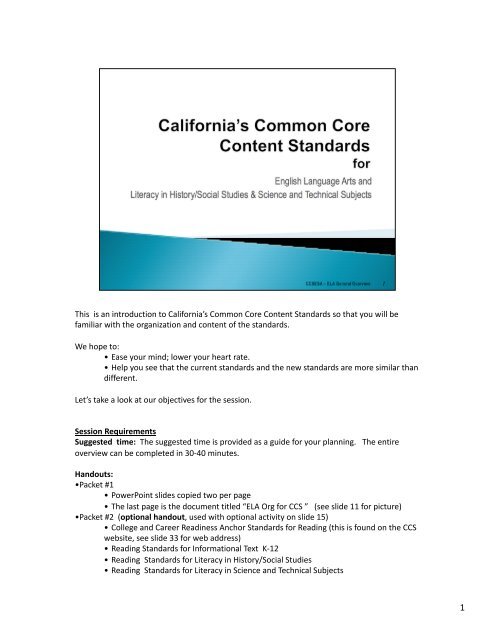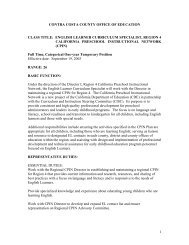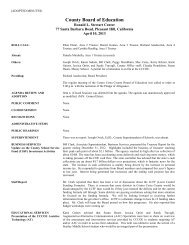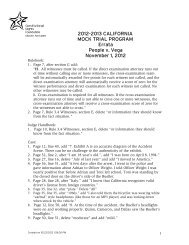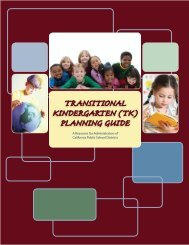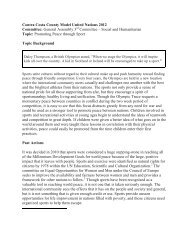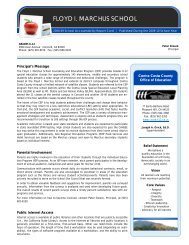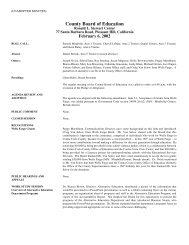You also want an ePaper? Increase the reach of your titles
YUMPU automatically turns print PDFs into web optimized ePapers that Google loves.
This is an introduction to California’s Common Core Content Standards so that you will be <br />
familiar with the organization and content of the standards. <br />
We hope to: <br />
• Ease your mind; lower your heart rate. <br />
• Help you see that the current standards and the new standards are more similar than <br />
different. <br />
Let’s take a look at our objectives for the session. <br />
Session Requirements <br />
Suggested time: The suggested time is provided as a guide for your planning. The entire <br />
overview can be completed in 30‐40 minutes. <br />
Handouts: <br />
• Packet #1 <br />
• PowerPoint slides copied two per page <br />
• The last page is the document titled “ELA Org for CCS ” (see slide 11 for picture) <br />
• Packet #2 (optional handout, used with optional activity on slide 15) <br />
• College and Career Readiness Anchor Standards for Reading (this is found on the CCS <br />
website, see slide 33 for web address) <br />
• Reading Standards for Informational Text K‐12 <br />
• Reading Standards for Literacy in History/Social Studies <br />
• Reading Standards for Literacy in Science and Technical Subjects <br />
1
We’ll begin with a general overview to help you understand the key design <br />
considerations used by the “architects” as they crafted these standards, <br />
including the additional 15% California added to the Common Core. <br />
Next, we’ll explain the organization of the standards and familiarize you <br />
with the terminology used in the new standards. <br />
We’ll also highlight similarities between the two sets of standards as well <br />
as some of the shifts or differences. <br />
Finally, we’ll point out the areas of emphasis in the new standards. <br />
2
The architects of the standards framed the work by keeping the following <br />
goal in mind: All students are college and career ready in literacy by no <br />
later than the end of high school. <br />
The standards provide a vision of what it means to be a literate person in <br />
the twenty‐first century and develop the skills in reading, writing, speaking, <br />
and listening that are foundational for any creative and purposeful <br />
expression in language. <br />
3
The design of the standards set requirements for English Language Arts <br />
AND Literacy in History/Social Studies & Science and Technical Subjects <br />
(we’ll explore the details of these sections later). <br />
4
Key design considerations are outlined in the Introduction of the Common Core State <br />
Standards. You can read more detail on your own at a later time if you download the document <br />
from the Common Core State Standards website (see last slide for web address). The <br />
Introduction was not included in California’s adoption. <br />
• College and Career Readiness (CCR) anchor standards <br />
o The CCR standards anchor the document and define general, cross‐disciplinary <br />
literacy expectations that must be met for students to be prepared to enter college and <br />
workforce training programs ready to succeed. <br />
o California did NOT include the anchor standards; however, they are the framework <br />
around which the standards are organized. <br />
• Grade levels for K‐8; grade bands for 9‐10 and 11‐12 <br />
o K‐8 are grade‐level specific. <br />
o 9/10 and 11/12 are two‐year bands. <br />
• A focus on results rather than means <br />
o Standards leave room for determination of how goals should be reached and what <br />
additional topics should be addressed. <br />
• An integrated model of literacy <br />
o Standards are divided into Reading, Writing, Speaking & Listening, and Language <br />
strands for conceptual clarity, yet document reflects their interconnectedness. <br />
• Research and media skills integrated into the Standards as a whole <br />
o Research and media skills and understandings are embedded throughout the <br />
standards rather than treated in a separate section. We’ll show you some examples of <br />
this later. <br />
• Shared responsibility for students’ literacy development <br />
o Students’ literacy development is not only the responsibility of the ELA teachers; <br />
teachers in other areas have a role in this development as well. This expectation will <br />
become clearer as we explain the structure of the standards. <br />
• Focus and coherence in instruction and assessment <br />
o While the Standards delineate specific expectations in reading, writing, speaking, <br />
listening, and language, each standard need not be a separate focus for instruction and <br />
assessment. Often, several standards can be addressed by a single rich task. <br />
5
The Introduction of the Common Core State Standards also describes what <br />
is NOT covered by the standards, the Intentional Design Limitations. <br />
The Standards do… <br />
• set grade‐level standards; they do not define the intervention <br />
methods or materials <br />
The Standards do… <br />
• allow for the widest possible range of students to participate fully <br />
permitting appropriate accommodations; they do not define the full <br />
range of supports appropriate for English learners and students with <br />
special needs <br />
The Standards do… <br />
• define general, cross‐disciplinary literacy expectations; they do not <br />
define the whole of college and career readiness <br />
6
The Intentional Design Limitations continue with the following: <br />
The Standards do… <br />
• define what all students are expected to know and be able to do; <br />
they do not define how teachers should teach <br />
The Standards do… <br />
• focus on what is most essential; they do not describe all that can or <br />
should be taught <br />
The Standards do… <br />
• establish a baseline for advanced learners; they do not define the <br />
nature of advanced work <br />
7
States could add up to 15% to the Common Core State Standards <br />
developed by the State Standards Initiative consortium. <br />
California added to the common core state standards based on the <br />
following criteria: <br />
• Substantively enhance <br />
• Address a perceived gap <br />
• Be defensible to classroom practitioners <br />
• Keep the original standard intact <br />
• Ensure the rigor of California’s existing standards is maintained <br />
In order to identify what was added, the Commission presented a draft to <br />
the State Board of Education with California’s Additional 15% indicated in <br />
bold and underlined font. <br />
The architects of the Common Core combined the best work of states. In <br />
fact, California’s standards played a large part in developing the foundation <br />
for the Common Core. Because of this, California did not necessarily add <br />
the full 15% that was allowed. In terms of word count for ELA, California <br />
added approximately 8%. <br />
8
California’s additional 15% includes the following: <br />
• Analysis of text features in informational text (Gr. 6‐12): For example, in grade 6 <br />
”Analyze the use of text features (e.g., graphics, headers, captions) in popular media” was <br />
added to Standard 5 to add specificity. <br />
• Included Career and Consumer Documents in Writing (Gr. 8): Career and consumer <br />
documents were not specifically called out in the Common Core. Therefore, “including <br />
career development documents (e.g., simple business letters and job applications)” was <br />
added to a CCS standard in order to add specificity. <br />
• Application of phonics and word analysis skills both in isolation and in text (Gr. K‐3): <br />
This was added to ensure that students were expected to apply these skills BOTH in <br />
isolation and in text. <br />
• Penmanship added to Language (Gr. 2‐4): CCS only included specific standards <br />
addressing penmanship in Kindergarten and Grade 1. <br />
• Formal presentations in Speaking and Listening (Gr. 1‐12): CCS placed more emphasis <br />
on collaborative conversations, formal presentations were specifically called out in the <br />
additional 15% – “Plan and deliver an informative/explanatory presentation…” <br />
• Minor additions and insertions to clarify (e.g., archetypes, thesis). <br />
Obviously, this is not an exhaustive list. Remember, in order to identify what was added, <br />
the Commission presented a draft to the Board with California’s additional 15% indicated <br />
in bold and underlined font. <br />
9
Let’s begin exploring the organization of the standards. <br />
The ELA standards are organized into three main sections. <br />
• A comprehensive K‐5 section; History/Social Studies & Science and <br />
Technical Subjects are embedded in these standards since <br />
instruction is typically provided by one teacher. <br />
• Two content‐area specific sections for grades 6‐12 <br />
• English Language Arts <br />
• History/Social Studies & Science and Technical Subjects (this <br />
will be explained in more detail later) <br />
There are four strands in the Common Core State Standards (the “strands” <br />
are called “domains” in the current CA standards): <br />
• Reading <br />
• Writing <br />
• Speaking and Listening (K‐12 ELA only – not included in the <br />
History/Social Studies & Science and Technical Subjects section) <br />
• Language: this strand includes conventions and vocabulary. (K‐12 <br />
ELA only – not included in the History/Social Studies & Science and <br />
Technical Subjects section) <br />
10
Find the handout at the back of your packet which outlines the organization of each strand. <br />
There are three sets of standards in the Reading Strand: Reading Standards for Literature, Reading <br />
Standards for Informational Text, and Reading Standards: Foundational Skills. <br />
In the first two sets, subheadings are consistent across grade levels: <br />
• Key Ideas and Details <br />
• Craft and Structure <br />
• Integration of Knowledge and Ideas <br />
• Range and Level of Text Complexity <br />
The third set of standards in the Reading Strand is Foundational Skills, included in K‐5 only. The <br />
subheadings are: <br />
• Print Concepts <br />
• Phonological Awareness <br />
• Phonics and Word Recognition <br />
• Fluency <br />
The Writing Strand includes one set of standards, and the subheadings are consistent across grade levels: <br />
• Text Types and Purposes <br />
• Production and Distribution of Writing <br />
• Research to Build and Present Knowledge <br />
• Range of Writing <br />
Speaking and Listening is one set of standards as well. Again, subheadings are consistent across grade <br />
levels: • Comprehension and Collaboration <br />
• Presentation of Knowledge and Ideas <br />
Finally, the Language Strand is one set of standards with consistent subheadings across grade‐levels: <br />
• Conventions of Standard English <br />
• Knowledge of Language <br />
• Vocabulary Acquisition and Use <br />
You may notice that Vocabulary is in the Language Strand of the Common Core, while in our current <br />
standards it is in the Reading domain. We’ll explore this shift later in the presentation.<br />
11
Here is a page taken from the K‐5 section of the standards. <br />
Instructor Note: Use the following questions to highlight important information on the <br />
slide. <br />
The standards on this page are from which strand? Reading <br />
Which set of standards in the Reading strand? Informational Text <br />
How many standards are in the Reading Standards for Informational Text across ALL <br />
grade levels? Ten <br />
What are the consistent subheadings? Key Ideas and Details; Craft and Structure; <br />
Integration of Knowledge and Ideas; Range of Reading and Level of Text Complexity <br />
What does the bold an underlined text in standard 4 and 10 indicate? Part of the 15% <br />
added by California <br />
12
Next, we’ll look at a standard to explore the organization of standards <br />
across grade levels. <br />
Remember, the Common Core State Standards were developed to build <br />
towards College and Career Readiness, using anchor standards to guide the <br />
progression across grade levels. While California did not include the CCR <br />
anchor standards, they are central to the organization– they are the <br />
framework used to design these standards and you will see how the <br />
knowledge and skills develop across grade levels. <br />
Remember the four strands identified on the handout. For each strand, <br />
anchor standards were used to organize the progression of standards <br />
across grade levels. <br />
• Reading: 10 anchor standards <br />
• Writing: 10 anchor standards <br />
• Speaking & Listening: 6 anchor standards <br />
• Language: 6 anchor standards <br />
13
What we’d like you to notice is how the numbers of the standards are <br />
consistent across grade‐levels, with the purpose of developing a particular <br />
knowledge or skill. At the top of the slide is the anchor standard from the <br />
Common Core. Note how the development of this standard progresses <br />
across grade levels. <br />
For example, In the Reading: Informational Text set of the standards, <br />
Standard 2 works toward the College and Career Readiness anchor <br />
standard “Determine central ideas or themes of a text and analyze their <br />
development; summarize the key supporting details and ideas.” <br />
Look at kindergarten, Grade 2, 4, 6, 8, and 11/12 on this and the following <br />
slide. You will see the progression across grade levels. While the anchor <br />
standards are not included in California’s adoption, the underlying <br />
structure remains. Therefore, the number used to reference each of the <br />
standards remain consistent across grade levels. <br />
14
CONTINUED <br />
Optional Activity (use packet #2) <br />
1. Review the College and Career Readiness Anchor Standards for Reading. <br />
2. Choose one of the Reading Standards for Informational Text. <br />
3. Trace that standard grades K‐12. Also trace it grades 6‐12 in the Reading <br />
Standards for Literacy for History/Social Studies AND Reading Standards for <br />
Literacy in Science and Technical Subjects. <br />
4. Share your observations with a partner. <br />
15
Now, we’ll take a look at some of the similarities between California’s <br />
current standards and the newly adopted Common Core Standards for <br />
California. <br />
California’s current standards are organized into four large categories <br />
called domains. The domains are: <br />
• Reading <br />
• Writing <br />
• Listening and Speaking <br />
• Written and Oral English Language Conventions <br />
The Common Core Standards for California are similarly organized into four <br />
groups called strands. The strands are: <br />
• Reading <br />
• Writing <br />
• Speaking and Listening <br />
• Language <br />
Let’s take a closer look at some of the standards and note their similar <br />
content. <br />
16
Compare California’s current standards with the Common Core Standards <br />
for California on this and the following two slides. Note the similarities in <br />
the content of the standards. <br />
17
CONTINUED <br />
18
CONTINUED <br />
Point out the bold and underlined text used to indicate California’s <br />
additional 15%. <br />
19
While the content of the standards is very similar, the placement within <br />
the organization of the standards may have shifted. <br />
You’ll note that in our current standards, vocabulary standards are found in <br />
the Reading Domain, while in the Common Core Standards for California, <br />
they are now in the Language Strand. <br />
Standards addressing conventions and grammar are in the Written and <br />
Oral English Language Conventions Domain of our current standards. These <br />
standards are now found in the Language Strand. <br />
It is important to keep these shifts in mind when comparing the two sets of <br />
standards. <br />
20
Let’s take a look at some shifts in Writing Applications. <br />
While our current standards specifically identify various writing <br />
applications across grade levels, the Common Core Standards for California <br />
organize the writing applications into three categories: <br />
1. Write Opinions (K‐5); Write Arguments (6‐12) <br />
2. Write Informative/Explanatory Texts <br />
3. Write Narratives <br />
If you compare the two lists, you will see that the various writing <br />
applications found in our current standards fit into one of the three <br />
categories of the Common Core Standards for California. <br />
21
One reason for this shift in the organization of writing standards is to <br />
better prepare students for college and career writing. This shift matches <br />
the NAEP (National Assessment of Educational Progress) framework. <br />
Notice the decreasing emphasis on writing to convey an experience <br />
(narrative) and the increase in writing to persuade or explain. <br />
22
Another shift is a more overt emphasis on shared responsibility for students’ literacy development. This <br />
was already part of California’s ELA and subject frameworks. These standards make the shared <br />
responsibility more overt. Our current History and Science frameworks already include many of the <br />
standards – so it is not really new to teach reading and writing in the subject areas. In fact, History and <br />
Science materials were recently adopted, so many districts have instructional materials in these content <br />
areas that do a good job of teaching and incorporating reading and writing. <br />
Instructor Note: Paraphrase the following paragraphs from the Introduction p. 2. <br />
The Standards insist that instruction in reading, writing, speaking, listening, and language be a shared <br />
responsibility within the school. The K–5 standards include expectations for reading, writing, speaking, <br />
listening, and language applicable to a range of subjects, including but not limited to ELA. The grades 6–<br />
12 standards are divided into two sections, one for ELA and the other for history/social studies, science, <br />
and technical subjects. This division reflects the unique, time‐honored place of ELA teachers in <br />
developing students’ literacy skills while at the same time recognizing that teachers in other areas must <br />
have a role in this development as well. <br />
Part of the motivation behind the interdisciplinary approach to literacy promulgated by the Standards is <br />
extensive research establishing the need for college and career ready students to be proficient in reading <br />
complex informational text independently in a variety of content areas. Most of the required reading in <br />
college and workforce training programs is informational in structure and challenging in content; <br />
postsecondary education programs typically provide students with both a higher volume of such reading <br />
than is generally required in K–12 schools and comparatively little scaffolding. <br />
Let’s take a look at who is responsible for which portion of the Standards. <br />
• In K‐5, since most of the instruction students receive comes from one teacher, there is a single set of <br />
grade‐specific standards for which the classroom teacher is responsible. <br />
• In grades 6‐12, there is one set of standards for which ELA teachers are responsible. <br />
• Another set of literacy standards for history/social studies, science, and technical subjects includes <br />
standards for which responsibility must be shared between ELA teachers and teachers in other content <br />
areas. <br />
• The literacy standards in history/social studies, science, and technical subjects are meant to <br />
complement rather than supplant content standards in those disciplines; the point is that there are <br />
discipline‐specific literacy skills that should be addressed in other content areas. <br />
23
Let’s look at some areas of emphasis in the Common Core State Standards. <br />
As we begin looking towards new assessments in 2014‐15, we want to <br />
teach with an awareness of what is emphasized in the Common Core <br />
standards. <br />
These standards: <br />
• Focus on text complexity <br />
• Address reading and writing across the curriculum <br />
• Emphasize analysis of informational text <br />
• Focus on writing arguments and drawing evidence from sources <br />
• Emphasize participating in collaborative conversation <br />
• Integrate media sources across standards <br />
Let’s see what is meant by each of these statements. <br />
24
Reading Standard 10 references a text complexity band beginning in <br />
Grade 2. <br />
Text complexity takes into account three factors: <br />
• Qualitative evaluation of the text: Levels of meaning, structure, <br />
language conventionality and clarity, and knowledge demands <br />
• Quantitative evaluation of the text: Readability measures and <br />
other scores of text complexity <br />
• Matching reader to text and task: Reader variables (such as <br />
motivation, knowledge, and experiences) and task variables (such <br />
as purpose and the complexity generated by the task assigned and <br />
the questions posed) <br />
You will find more information on text complexity within the body of the <br />
standards (two pages that follow the K‐5 and the 6‐12 ELA standards) and <br />
in Appendix A (research) and Appendix B (illustrative texts) which were <br />
not included in California’s adoption. <br />
25
The standards emphasize reading and writing across curricular areas. You <br />
will see this reflected in these example standards from Grade 5 and Grades <br />
9‐10. <br />
26
CONTINUED <br />
Presenter note: Reminder of the organization of the standards <br />
• Reading Standards for Literacy in History/Social Studies <br />
• Reading Standards for Literacy in Science and Technical Subjects <br />
(two separate sections) <br />
• Writing Standards for Literacy in History/Social Studies and Science <br />
and Technical Subjects (one combined section) <br />
27
An awareness of the emphasis on Informational Text is critical in ensuring <br />
student success. <br />
The standards aim to align with NAEP in the distribution of literary and <br />
informational text. This emphasis on informational text must begin K‐3, <br />
because as you can see, by Grade 4 the distribution is 50/50. <br />
Note that literary non‐fiction is included in the Literary category, and this <br />
includes essays, speeches, and biographies. Therefore, the actual volume <br />
of informational text may be even higher than what is outlined in this <br />
table. <br />
It is important to note that the high percentages of informational text in <br />
high school is a shared responsibility between ELA teachers and teachers in <br />
other disciplines. This does not mean that all 70% of informational reading <br />
needs to happen in the ELA classrooms. <br />
28
This sample from seventh grade is just one example. As with all of the <br />
standards, there is a progression across grade levels. <br />
29
California’s current standards place more of an emphasis on formal <br />
presentation. The Common Core Standards add an emphasis on <br />
collaborative conversations; a skill that one might argue is used on an <br />
everyday basis. <br />
Here is an example of a Speaking and Listening standard addressing <br />
Collaborative Conversation. Take a moment to read the standard. <br />
Presenter note: One formal speech is called out at each grade level. <br />
30
Another emphasis is on integrating media sources. Research and media skills are <br />
blended into the Standards as a whole. <br />
INSTRUCTOR NOTE: Paraphrase the following paragraph from the Introduction. <br />
To be ready for college, workforce training, and life in a technological society, <br />
students need the ability to gather, comprehend, evaluate, synthesize, and <br />
report on information and ideas, to conduct original research in order to answer <br />
questions or solve problems, and to analyze and create a high volume and <br />
extensive range of print and non‐print texts in media forms old and new. The <br />
need to conduct research and to produce and consume media is embedded <br />
into every aspect of today’s curriculum. In like fashion, research and media <br />
skills and understandings are embedded throughout the Standards rather than <br />
treated in a separate section. <br />
Let’s take a look at this integration into the standards as a whole. <br />
You’ll see from these Grade 6 examples, the use of media sources is integrated <br />
across the strands. Take a moment to read the example standards. <br />
These are only a few examples from Grade 6. It is important to note that this is <br />
not an exhaustive list; there are numerous examples of integration of media <br />
sources within each grade level across the strands. <br />
31
Throughout the presentation we have referenced the Introduction, College <br />
and Career Readiness anchor standards, and the Appendices, which were <br />
not included in California’s adoption. These documents may support your <br />
understanding of the organization and structure of the ELA standards and <br />
can be found at www.corestandards.org which is on the final slide. <br />
32
Allow a moment for comments and questions. <br />
33


